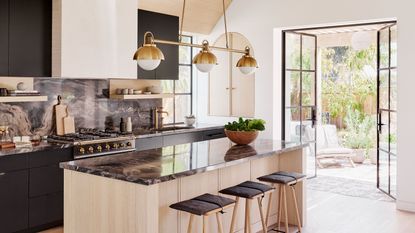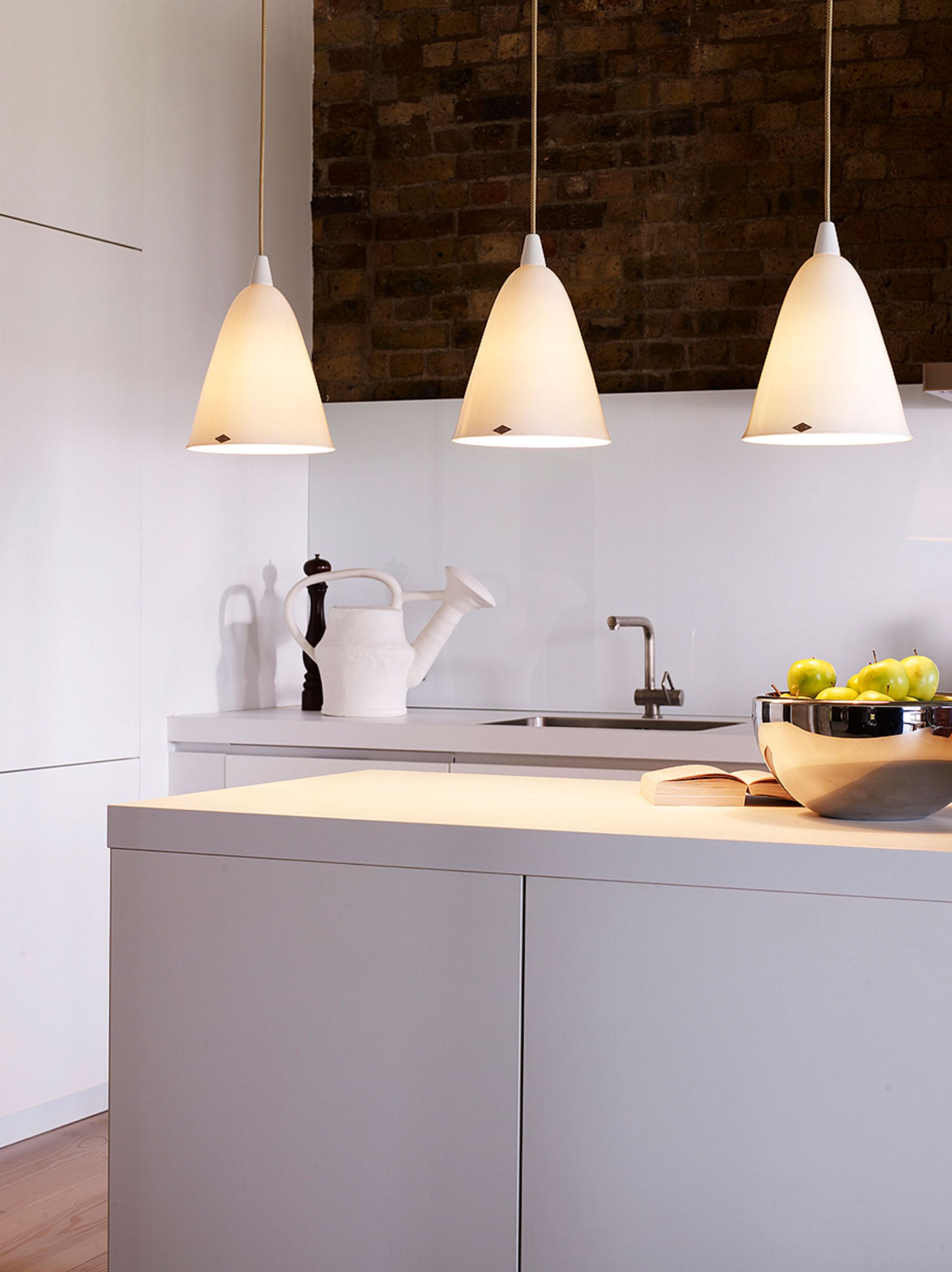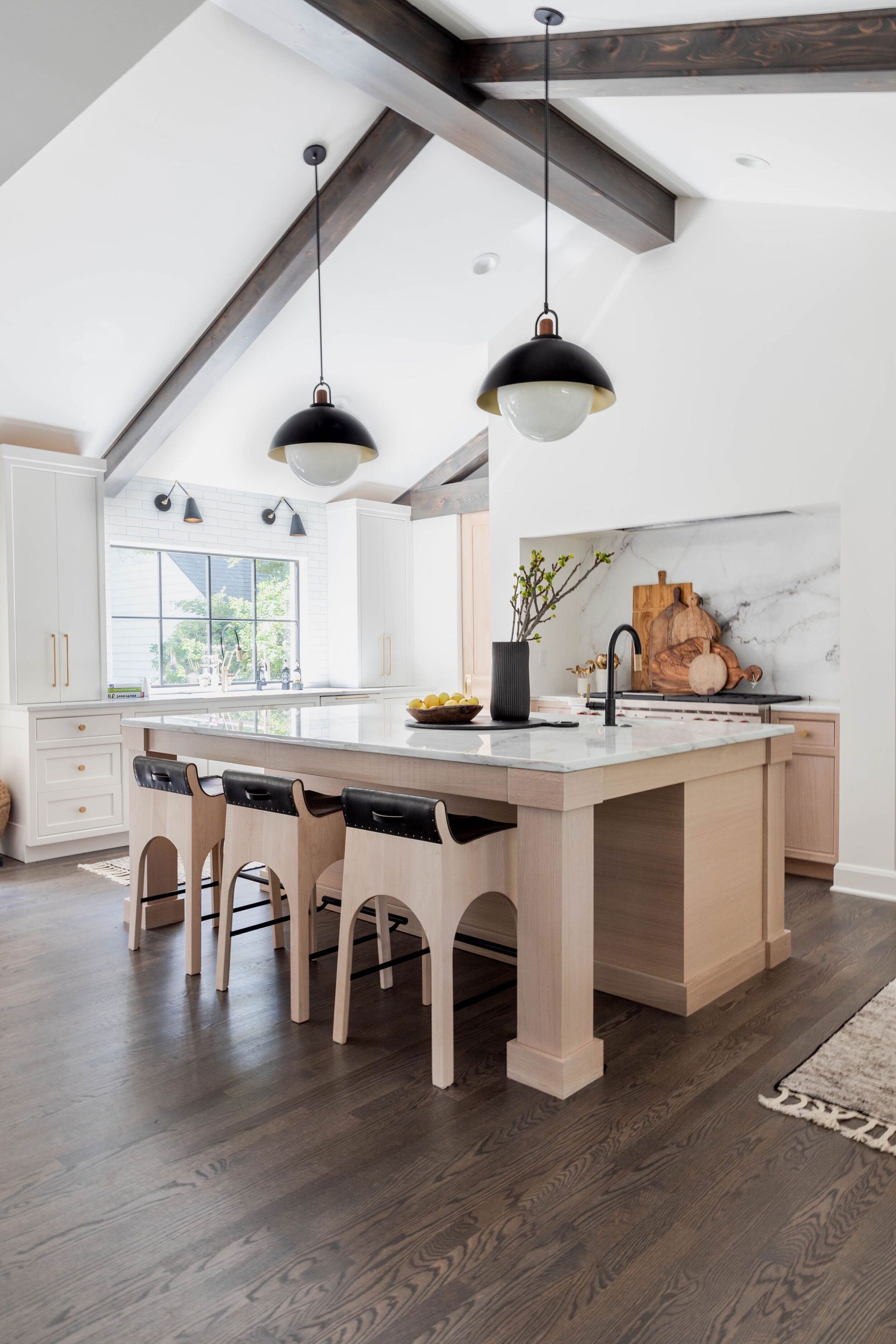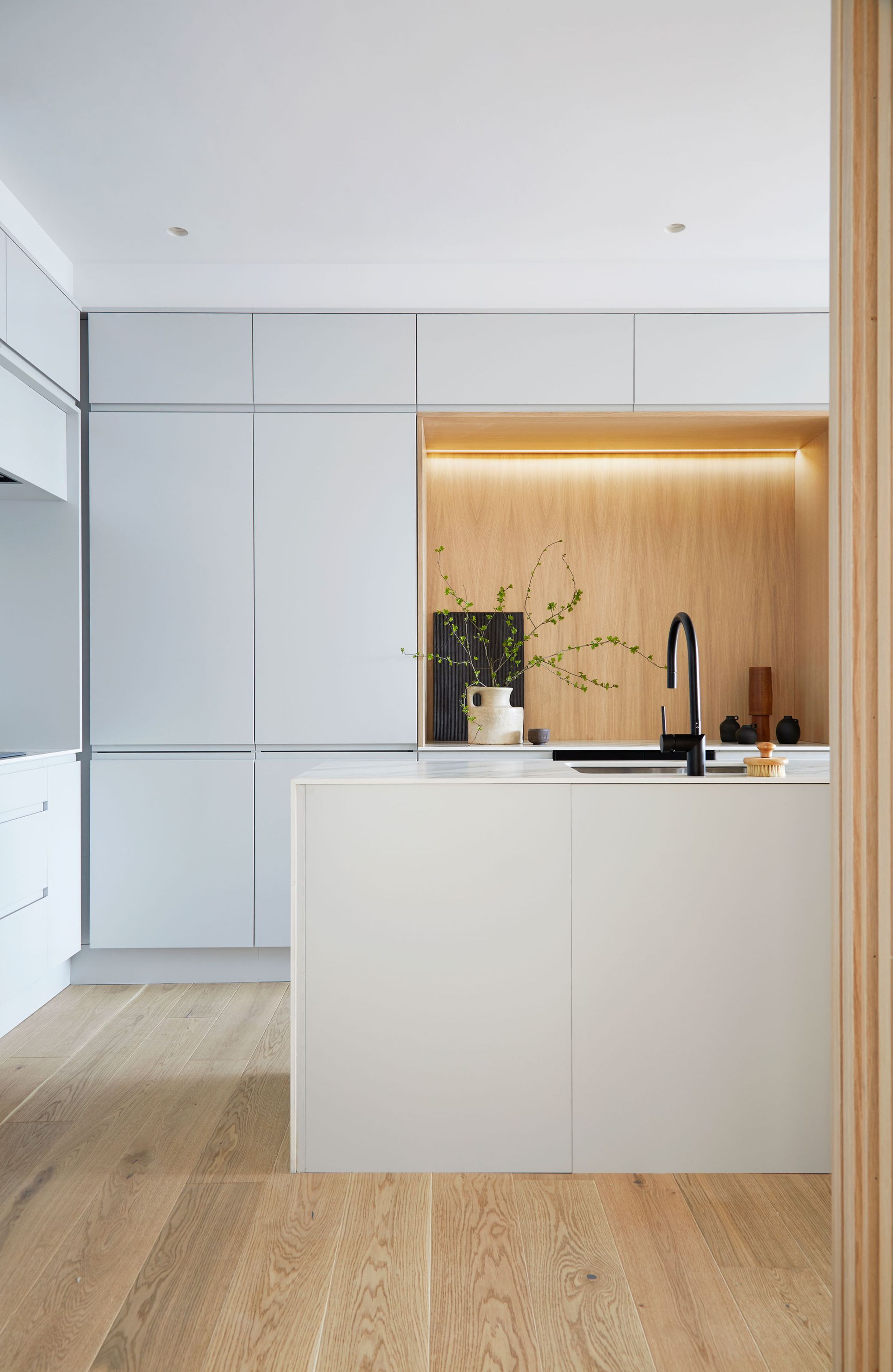Kitchen lighting design – interior designers and architects explain how to plan the perfect scheme
We've asked the professionals to offer up their kitchen lighting design secrets so that you can create a practical, well-lit space with ease


It’s important to start thinking about kitchen lighting design as early as possible in your project – and by that, we don’t mean simply choosing out the pendant light you want for over the kitchen island.
While it’s easy to be seduced by stylish and glamorous kitchen lighting ideas, it’s the practical nature of lighting this space that you need to get to grips with, especially where you’re meeting the brief for a space that’s the heart and hub of your home.
‘Kitchens are now, more than ever, one of the most flexible rooms that we have in our homes,’ says Sanjit Bahra, lighting designer and principal at Design Plus Light. ‘Not everyone can have a separate dining room and study. Most of us now work from home in the kitchen during the day, do homework, and then want to create a relaxed domestic dining setting in the evening.’
‘Lighting is one of the most powerful tools to change the mood, ambiance, and feel of a space. Our lighting requirements are now specific to the task at hand.’
It’s worth remembering that kitchen lighting design isn’t easy to perfect, after all, there are specialist lighting designers whose job is to understand how lighting affects the design and practicality of the space. ‘These experts know how to select the correct style of lighting, the warmth of lighting, and where they should be positioned for optimum look and function,’ says Roundhouse kitchen designer Allison Lynch.
But, if you are going it alone with your kitchen lighting design, we’ve curated the top advice from architects and designers, of both lighting and kitchens, to help you create a better-considered lighting scheme.
How to plan kitchen lighting design
The key to a good kitchen lighting design is in combining fixtures. ‘Create layers of light using various types of lighting,’ suggests interior designer Katie McCrum of McCrum Studio. ‘This will help change the mood from a hard-working kitchen to an intimate space to eat, relax and enjoy.’
But how much lighting is enough for your kitchen? ‘It all depends on how large your kitchen is, what you want to do in the space, and at what point you’re installing the lighting,’ says Sanjit. ‘A brand new project will have much more scope than a soft refurb.’
Some lighting schemes will better suit small kitchen lighting ideas, while others play out better over a larger scale.

What kind of lighting is best for kitchens?
The best type of lighting for a kitchen will depend on how it’s being used at that moment, and getting the balance of these different kinds of lighting right is what helps you to create a versatile, layered lighting scheme that looks its best any time of day and whatever it’s being used for.
‘When approaching kitchen lighting, you need to break it down into three areas: ambient lighting for general use, task lighting, which is typically over counters, and ambient lighting to create the mood,’ explains James Veal, co-founder of Brooklyn-based architecture and design studio Stewart-Schafer.
Accent lighting, sometimes referred to as feature lighting, is another element to consider, though this sits apart to some degree as a decorative form of lighting used to train the eye around your kitchen.
‘Ambient lighting is typically achieved with ceiling recessed fixtures,’ says James, but downlights can also be used for task lighting, over a kitchen island for instance. The difference may just be in the type of light you specify. ‘You want to make sure the beam angle works with the height of the ceiling, and for ambient light, it’s typically a wider spread above 40 degrees,’ he suggests.

‘Task lighting, on the other hand, is typically a high-quality light, over working areas, and can be higher in temp if you want – nearer the 4000k with a narrow beam spread to hit the surface and illuminate as needed.’
Accent lighting tends to be as soft and warm as your ambient mood lighting, and can be used in a variety of ways, from kitchen cabinet lighting to wash down a feature splashback to on top of cabinetry to highlight a ceiling and create a diffused glow.
However, it’s not so easy as to simply assign different types of light fixtures to these different categories. ‘The going trend for many years was to have can lights in the ceiling or track lighting mounted there serve as the ambient layer,’ says Los Angeles-based interior designer and creative director of Hudson Valley Lighting Group Ben Marshall, ‘but you can have a decorative ambient layer, whether it’s through installing a matching set of semi flush-mounts or a chandelier above an adjacent dining area.’
Used in the right application, any kind of light fixture might be able to provide any type of lighting, but when it comes to the best type of lighting for a kitchen design, you really shouldn’t overlook or underestimate task lighting. While an attractive, balanced ambient lighting scheme might feel like the biggest concern, you’ll find yourself even more frustrated with insufficient light to be able to use your kitchen properly.

‘You could make the argument that all lighting in the kitchen is task lighting. Pendants or a linear light over the island lights food prep,’ adds Ben. ‘An articulated sconce or one-light pendant above the kitchen sink provides task light for cleaning dishes while adding a touch of decorative beauty. Even sconces above open shelving serve a function..'
However, lighting designer Sanjit Bahra believes that it’s unwise to rely on decorative lighting to provide task lighting, especially kitchen pendant lighting ideas, suggesting that task lighting should be a background, supporting character. ‘I try to sneak in a downlight on either side of a pendant to light the table below and then it gives the illusion that the beautifully dimmed pendant is doing all the work.’
How do you lay out kitchen lights?
When it comes to kitchen lighting design, some of your layout will be determined by your visual choices. Kitchen island lighting ideas, for example, tend to focus on pendant lights, but not always, and there are some creative ways you can use them that don’t just focus on the island.
The layout of downlights will be something that you’ll eventually broach with your contractor as part of your kitchen ceiling lighting ideas, and it's a topic that they’ll no doubt be happy to have some input in. Remember, your ceiling joists will need to be taken into consideration, which can also affect placement.
There are a few rules of thumb that are often used by designers, such as ensuring downlights are at least 2-3 feet away from the edges of the room and that the space between each downlight should be half the ceiling height of the space. Yet, all of these elements depend on the width of the beam of light for your downlights and where in a space they’re being used.

There’s also the question of balancing the number of downlights you need to use. Obviously, you need to provide sufficient lighting, but too many downlights, and your ceiling becomes cluttered and busy to look at. ‘We like symmetrical placement and good lines so your eye can follow, even into other rooms in terms of placing them,’ says Stewart-Schafer’s James Veal.
The practicality of your lighting layout will also be affected by the circuits it’s placed on. Zoning downlights across a larger space, for example, will give you greater control, something that’s particularly important for open plan kitchen ideas where the space is used for different functions by multiple people.
‘We usually have 2 or 3 circuits,’ says interior designer Katie McCrum, ‘one for the main task lights, one for the feature lights such as wall lights and pendants together and another one for under counter or plinth LED lights.’ In a large kitchen, this may require more circuits for different zones for the downlights, but also needs to be balanced with not creating a mass of switches, where you can never find the switch for the lighting you’re looking for.
What color temperature should kitchen lighting be?
Light color temperature is tricky to balance in a kitchen. In general, task lighting tends to be a whiter, brighter temperature, while ambient lighting is warmer, but dimmer. The tried and trusted light color for ambient lighting in kitchens is 2700K.
'During the day, when working at the kitchen worktop or on a ‘client zoom’ call – you generally want bright diffuse lighting that lights the work surface and provides a pleasant image on the screen,' explains lighting designer Sanjit Bahra. 'The light levels and mood you may want at 4pm in December when kids are doing homework will be very different to cooking dinner at 7pm or an intimate candle-lit date at home.'
However, using two-color temperatures of lighting in the same space, especially where those lights are meant to be layered in use at the same time, can go sideways if not carefully considered. Interior designer Katie McCrum, for example, doesn't opt to use cool-toned lighting: 'I always plump for warm white lamps/bulbs,' she says, 'and leave the cold white for commercial environments.'

Some lighting designers will use more than one color tone in a kitchen, meeting the need for a cooler light for better task lighting. However, where 2700K might be the optimum general ambient lighting, mixing in an only-slightly cooler light, around 3000K, would be preferable in this instance, compared to something vastly whiter.
Mixing color temperatures might also depend on the use of each function. If the accent under cabinet lighting isn't ever going to be on at the same time as the task lighting downlights, the clash of these two light colors doesn't need to be feared as much in the design.
Are LED light good for kitchens?
‘Use LED bulbs,’ says architecture and design studio Stewart-Schafer’s co-founder James Veal. ‘They have come a long way in tech, and the cost has come down dramatically, and the quality of light is excellent and will save on energy bills.’
LEDs also offer you more exciting design applications, especially for kitchen cabinet lighting ideas. ‘Consider using LED feature lighting to really soften the mood such as backlit shelves,’ suggests interior designer Katie McCrum. However, any LED strip lighting should be used alongside an opal diffuser, according to lighting designer Sanjit Bahra: ‘No one wants to see points of light when sitting at the dining table or reflected in the countertop below.’
You’ll also need to make sure when using integrated LED lighting or LED bulbs that your choice is compatible with the switch you use. Some, but not all bulbs and integrated LEDs are compatible with dimmer switches for example, and if you choose one that isn’t you’ll likely find the light flickers and the switch lets out an unpleasant hum.
All lighting manufacturers should have compatibility charts, and sometimes, retailers will have two versions of fixtures for different dimmer compatibility. Some higher-end switch fixtures have built-in LED compatibility also, however.

When should I consider my lighting design for a kitchen project?
Depending on whether you’re undertaking a ‘soft’ kitchen refurb or a major kitchen remodel may change how you can adapt your kitchen lighting. Rewiring a space will allow for greater control on how and where your lights are operated, for example.
‘If you’re at the earlier stages of your planning or have the opportunity to relocate some electrical points, think about the circulation in the kitchen,’ suggests New York-based interior designer Ahmad AbouZanat of Project AZ. ‘You might need a three-way switch for one of the lights or all of them.’ This is particularly important when you have two points of entry to your kitchen, as you’ll want to be able to turn the lights on from both entryways.
Regardless, kitchen lighting design should be considered from the outset of the kitchen project, considered an integral part of the design process rather than an additional extra.
Be The First To Know
The Livingetc newsletter is your shortcut to the now and the next in home design. Subscribe today to receive a stunning free 200-page book of the best homes from around the world.

Hugh is the Editor of Livingetc.com. From working on a number of home, design and property publications and websites, including Grand Designs, ICON and specialist kitchen and bathroom magazines, Hugh has developed a passion for modern architecture, impactful interiors and green homes. Whether moonlighting as an interior decorator for private clients or renovating the Victorian terrace in Essex where he lives (DIYing as much of the work as possible), you’ll find that Hugh has an overarching fondness for luxurious minimalism, abstract shapes and all things beige. He’s just finished a kitchen and garden renovation, and has eyes set on a bathroom makeover for 2024.
-
 How to Thaw a Frozen Pipe — Learn Everything You Need to Know in 5 Minutes With This Guide
How to Thaw a Frozen Pipe — Learn Everything You Need to Know in 5 Minutes With This GuideWinter storm caught you off guard? We asked an expert — just how do you thaw a frozen pipe?
By Hugh Metcalf Published
-
 The 12 Very Best Silk Bedding Pieces — As Our Style Editor Says: 'It's What Dreams Are Made Of!'
The 12 Very Best Silk Bedding Pieces — As Our Style Editor Says: 'It's What Dreams Are Made Of!'Slumber in lustrous luxury with the very best silk bedding sheets, duvets, pillowcases, and more — your sleep score will thank us later
By Julia Demer Published

